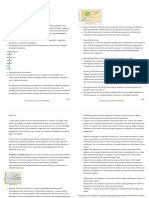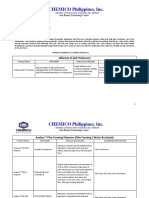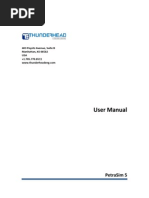3.1 WBK
3.1 WBK
Uploaded by
kimjimCopyright:
Available Formats
3.1 WBK
3.1 WBK
Uploaded by
kimjimOriginal Title
Copyright
Available Formats
Share this document
Did you find this document useful?
Is this content inappropriate?
Copyright:
Available Formats
3.1 WBK
3.1 WBK
Uploaded by
kimjimCopyright:
Available Formats
Section
Name Date
How Changes Occur Naturally in
3.1
Summary
Ecosystems
Textbook pages 108–121
Before You Read
How do you think mature forests, such as the temperate rainforests of coastal British
Columbia, change over time? Write your answer on the lines below.
◆
How do organisms adapt to change?
? Create an Outline
In natural selection, the best-adapted members of a species
Create an outline highlighting survive to reproduce. These individuals may pass favourable
the typical changes that occur characteristics on to their offspring. As abiotic and biotic
in an ecosystem undergoing
primary succession.
components of their environment change, adaptive radiation
may result. This term describes the change from a common
ancestor into a number of different species that “radiate out”
to inhabit different niches. For example, 13 species of finches
that fill different niches on the Galapagos Islands are thought
to have developed from a single species from mainland South
America. ● ✔
●
✔ Reading Check
1. What is adaptive radiation?
How do ecosystems change over time?
Ecological succession refers to changes that take place over
time in the types of organisms that live in an area. There are
two types of ecological succession:
1. Primary succession: Primary succession occurs in areas
where no soil exists, such as following glaciation or a lava
flow. Wind and rain carry spores of lichens to these areas.
Lichens obtain nutrients by secreting chemicals that break
down rock. As lichens decay, they add organic matter
to the developing soil. The first organisms to survive and
reproduce in an area are called pioneer species. They
are adapted to grow in harsh, nutrient-poor conditions.
In time, often over hundreds of years, the weathering of
rocks and decay of pioneer species cause soil formation.
The abiotic conditions of the ecosystem continue to
change as new species of plants and animals colonize the
area, each competing for nutrients, moisture, and sunlight.
More niches are created and biodiversity increases.
38 MHR • Section 3.1 How Changes Occur Naturally in Ecosystems © 2008 McGraw-Hill Ryerson Limited
038_055_BCSci10_U1CH03_098461.in38 38 Pdf 2nd 6/30/08 6:03:11 PM
Section
Name Date
3.1
Summary
continued
Eventually, primary succession leads to the development
of mature climax communities, such as a boreal forest or
grassland.
2. Secondary succession: Small disturbances, such a fire,
often occur in ecosystems. Secondary succession— ●
✔ Reading Check
2. Describe the difference
succession that occurs as a result of a disturbance to an
between primary and
area that already has soil and was once the home of living secondary succession.
organisms—occurs as a result. It proceeds much faster
than primary succession since micro-organisms, insects,
seeds, and nutrients still exist in the soil. ●
✔
How do natural events affect ecosystems?
Natural events can destroy habitats, reduce biodiversity, and
cause regions to undergo succession. Some examples include:
• flooding: results in soil erosion, pollution, and disease
when toxins or harmful bacteria from untreated sewage
enter drinking water
• drought: plants and animals die due to lack of water
• insect infestations: often result in succession in forests
because insects destroy older, weaker trees
• tsunamis: huge, rapidly moving ocean waves destroy
habitats and salt water carried onto shore changes soil
composition
© 2008 McGraw-Hill Ryerson Limited Section 3.1 How Changes Occur Naturally in Ecosystems • MHR 39
038_055_BCSci10_U1CH03_098461.in39 39 Pdf 2nd 6/30/08 6:03:13 PM
Cloze
Name Date Activity
Section 3.1
Use with textbook pages 108–117.
Change in ecosystems
Vocabulary
adaptive radiation natural selection
climax community pioneer species
drought primary succession
ecological succession secondary succession
flooding tsunami
insect infestations
Use terms in the vocabulary box to fill in the blanks. Use each term only once.
1. In the process of , living organisms change as the abiotic and
biotic components in their environment change.
2. describes the change from a common ancestor into a number
of different species that “radiate out” to inhabit different niches.
3. Scientists use the term to refer to changes that take place
over time in the types of organisms that live in an area.
4. occurs in an area where no soil exists, such as on bare rock.
5. The lichens and others plants that are the first organisms to survive and reproduce in
an area are known as .
6. The process of primary succession leads to the development of a mature community,
which is sometimes called a .
7. occurs as the result of a disturbance to an area that already
has soil and was once the home of living organisms.
8. can result in soil erosion and soil pollution if toxic chemicals
are present in floodwaters.
9. is a huge, rapidly moving ocean wave.
10. can result in crop failures and livestock deaths.
11. , such as the mountain pine beetle in the forests of British
Columbia, have a devastating effect on the forest canopy, and bird and mammal
habitats.
40 MHR • Section 3.1 How Changes Occur Naturally in Ecosystems © 2008 McGraw-Hill Ryerson Limited
038_055_BCSci10_U1CH03_098461.in40 40 Pdf 2nd 6/30/08 6:03:15 PM
Analyzing
Name Date Information
Section 3.1
1.1
Use with textbook pages 111–114.
Primary and secondary succession
1.
Glacier Retreating
As a glacier retreats, the process of primary succession will occur. Describe the various
stages that lead to the development of a mature community.
2. Results of Forest Fire
After a forest fire, not much is left except ash and burnt trees. Describe the sequence of
events that will occur during secondary succession.
© 2008 McGraw-Hill Ryerson Limited Section 3.1 How Changes Occur Naturally in Ecosystems • MHR 41
038_055_BCSci10_U1CH03_098461.in41 41 Pdf 2nd 6/30/08 6:03:17 PM
Applying
Name Date Knowledge
Section 3.1
Use with textbook pages 115–117.
How natural events affect ecosystems
For each major event listed below, summarize the effects on their mature
communities.
Natural event Effects on mature community
Fire
Flooding
Tsunami
Drought
Insect infestation
42 MHR • Section 3.1 How Changes Occur Naturally in Ecosystems © 2008 McGraw-Hill Ryerson Limited
038_055_BCSci10_U1CH03_098461.in42 42 Pdf 2nd 6/30/08 6:03:20 PM
Name Date
Assessment
Section 3.1
Use with textbook pages 108–117.
How changes occur
naturally in ecosystems
Match each Term on the left with the best
Descriptor on the right. Each Descriptor may be
7. Each of these finches from the Galapagos
used only once.
Islands has evolved different shapes and
Term Descriptor sizes of beaks. This is an example of:
1. adaptive A. a mature commu- A. primary succession
radiation nity that continues to
2. climax change over time B. secondary succession
community B. the development C. bioremediation
3. ecological of a number of new
succession species from a com- D. adaptive radiation
4. natural selection mon ancestor
5. pioneer species C. organisms, such as
lichens and other
plants, that are the first
to survive and repro-
duce in an area 0 Years 300 Years
D. changes that take
place over time in the
8. The diagram above represents which of the
types of organisms that
following:
live in an area A. adaptive radiation
E. the process in which,
over time, the best B. climax community
adapted members of a C. ecological succession
species will survive and
D. natural succession
reproduce
9. An example of a pioneer species would be
Circle the letter of the best answer.
A. moss
6. The process that makes change possible in
living things is B. lichen
A. ecological succession C. deciduous trees
B. primary succession D. coniferous trees
C. natural selection
D. adaptive radiation
© 2008 McGraw-Hill Ryerson Limited Section 3.1 How Changes Occur Naturally in Ecosystems • MHR 43
038_055_BCSci10_U1CH03_098461.in43 43 Pdf 2nd 6/30/08 6:03:22 PM
You might also like
- 02 - THCS- Tổ Chức Dạy Hoc Tiếng Anh ở Trường100% (3)02 - THCS- Tổ Chức Dạy Hoc Tiếng Anh ở Trường3 pages
- Edexcel A2 IAL Biology: Topic 5 - On The Wild Side100% (1)Edexcel A2 IAL Biology: Topic 5 - On The Wild Side17 pages
- Ecological Succession: Ecological Succession Is The Observed Process of Change in TheNo ratings yetEcological Succession: Ecological Succession Is The Observed Process of Change in The24 pages
- Functions of An Ecosystem - Succession and HomeostasisNo ratings yetFunctions of An Ecosystem - Succession and Homeostasis6 pages
- GABALY (GROUPAGE UDUKAYE TUDODWA) Section-2 (13-24)No ratings yetGABALY (GROUPAGE UDUKAYE TUDODWA) Section-2 (13-24)12 pages
- Question 1. Explain Four Phases of Ecological SuccesionNo ratings yetQuestion 1. Explain Four Phases of Ecological Succesion3 pages
- Module 2 (People and The Earth's Ecosystem)0% (2)Module 2 (People and The Earth's Ecosystem)11 pages
- Fires, Ecological Effects Of: William BondNo ratings yetFires, Ecological Effects Of: William Bond9 pages
- 2.1.3 - Scientific Understandings of Outdoor Environments - Part 2 Student100% (2)2.1.3 - Scientific Understandings of Outdoor Environments - Part 2 Student16 pages
- Foundations of Terrestrial Ecosystems: The Earth's Web, #1From EverandFoundations of Terrestrial Ecosystems: The Earth's Web, #1No ratings yet
- Environmental Science a - Unit 1 Part 2 - Hypotheses Theories and Laws GN SENo ratings yetEnvironmental Science a - Unit 1 Part 2 - Hypotheses Theories and Laws GN SE14 pages
- It Is Better To Have A Permanent Income Than To Be FascinatingNo ratings yetIt Is Better To Have A Permanent Income Than To Be Fascinating40 pages
- EVS Lecture II 8 EndangeredandEndemicSpeciesofIndiaNo ratings yetEVS Lecture II 8 EndangeredandEndemicSpeciesofIndia12 pages
- Munro5@chass - Utoronto.ca John - Munro@utoronto - CaNo ratings yetMunro5@chass - Utoronto.ca John - Munro@utoronto - Ca42 pages
- Munro5@chass - Utoronto.ca John - Munro@utoronto - CaNo ratings yetMunro5@chass - Utoronto.ca John - Munro@utoronto - Ca45 pages
- Prof. John H. Munro ECO. 301Y1: Munro5@chass - Utoronto.ca John - Munro@utoronto - CaNo ratings yetProf. John H. Munro ECO. 301Y1: Munro5@chass - Utoronto.ca John - Munro@utoronto - Ca16 pages
- Adaptive Learning Systems Enhancing Student EngagementNo ratings yetAdaptive Learning Systems Enhancing Student Engagement28 pages
- (Yabanci Dil Testi) : T.C. Millî Eğitim Bakanliği Ölçme, Değerlendirme Ve Sinav Hizmetleri Genel MüdürlüğüNo ratings yet(Yabanci Dil Testi) : T.C. Millî Eğitim Bakanliği Ölçme, Değerlendirme Ve Sinav Hizmetleri Genel Müdürlüğü23 pages
- Grade 8 Natural Sciences Common Test Term 1 Memorandum 2023No ratings yetGrade 8 Natural Sciences Common Test Term 1 Memorandum 20236 pages
- Strategic Management and Leadership Skills by Tamoor AzizNo ratings yetStrategic Management and Leadership Skills by Tamoor Aziz18 pages
- Modelling of The Cathodic Protection System With Dynamic Non-Linear Polarization CharacteristicsNo ratings yetModelling of The Cathodic Protection System With Dynamic Non-Linear Polarization Characteristics5 pages
- Nursing Theory Development: (Analysis-Synthesis-Derivation)No ratings yetNursing Theory Development: (Analysis-Synthesis-Derivation)45 pages
- R. M. Lala - The Creation of Wealth _ the Tatas From the 19th to the 21st CenturyNo ratings yetR. M. Lala - The Creation of Wealth _ the Tatas From the 19th to the 21st Century332 pages
- Beam To Column'S Flange Fixed Connection - Bcff-2: Design DataNo ratings yetBeam To Column'S Flange Fixed Connection - Bcff-2: Design Data5 pages
- Vdoc - Pub Power System Analysis A Dynamic Perspective100% (2)Vdoc - Pub Power System Analysis A Dynamic Perspective809 pages
- Learning Activity 3 / Actividad de Aprendizaje 3No ratings yetLearning Activity 3 / Actividad de Aprendizaje 311 pages
- Antistatic and Spark Resistance Floorings HrischevNo ratings yetAntistatic and Spark Resistance Floorings Hrischev5 pages
- Edexcel A2 IAL Biology: Topic 5 - On The Wild SideEdexcel A2 IAL Biology: Topic 5 - On The Wild Side
- Ecological Succession: Ecological Succession Is The Observed Process of Change in TheEcological Succession: Ecological Succession Is The Observed Process of Change in The
- Functions of An Ecosystem - Succession and HomeostasisFunctions of An Ecosystem - Succession and Homeostasis
- GABALY (GROUPAGE UDUKAYE TUDODWA) Section-2 (13-24)GABALY (GROUPAGE UDUKAYE TUDODWA) Section-2 (13-24)
- Question 1. Explain Four Phases of Ecological SuccesionQuestion 1. Explain Four Phases of Ecological Succesion
- 2.1.3 - Scientific Understandings of Outdoor Environments - Part 2 Student2.1.3 - Scientific Understandings of Outdoor Environments - Part 2 Student
- Foundations of Terrestrial Ecosystems: The Earth's Web, #1From EverandFoundations of Terrestrial Ecosystems: The Earth's Web, #1
- Environmental Science a - Unit 1 Part 2 - Hypotheses Theories and Laws GN SEEnvironmental Science a - Unit 1 Part 2 - Hypotheses Theories and Laws GN SE
- It Is Better To Have A Permanent Income Than To Be FascinatingIt Is Better To Have A Permanent Income Than To Be Fascinating
- EVS Lecture II 8 EndangeredandEndemicSpeciesofIndiaEVS Lecture II 8 EndangeredandEndemicSpeciesofIndia
- Munro5@chass - Utoronto.ca John - Munro@utoronto - CaMunro5@chass - Utoronto.ca John - Munro@utoronto - Ca
- Munro5@chass - Utoronto.ca John - Munro@utoronto - CaMunro5@chass - Utoronto.ca John - Munro@utoronto - Ca
- Prof. John H. Munro ECO. 301Y1: Munro5@chass - Utoronto.ca John - Munro@utoronto - CaProf. John H. Munro ECO. 301Y1: Munro5@chass - Utoronto.ca John - Munro@utoronto - Ca
- Adaptive Learning Systems Enhancing Student EngagementAdaptive Learning Systems Enhancing Student Engagement
- (Yabanci Dil Testi) : T.C. Millî Eğitim Bakanliği Ölçme, Değerlendirme Ve Sinav Hizmetleri Genel Müdürlüğü(Yabanci Dil Testi) : T.C. Millî Eğitim Bakanliği Ölçme, Değerlendirme Ve Sinav Hizmetleri Genel Müdürlüğü
- Grade 8 Natural Sciences Common Test Term 1 Memorandum 2023Grade 8 Natural Sciences Common Test Term 1 Memorandum 2023
- Strategic Management and Leadership Skills by Tamoor AzizStrategic Management and Leadership Skills by Tamoor Aziz
- Modelling of The Cathodic Protection System With Dynamic Non-Linear Polarization CharacteristicsModelling of The Cathodic Protection System With Dynamic Non-Linear Polarization Characteristics
- Nursing Theory Development: (Analysis-Synthesis-Derivation)Nursing Theory Development: (Analysis-Synthesis-Derivation)
- R. M. Lala - The Creation of Wealth _ the Tatas From the 19th to the 21st CenturyR. M. Lala - The Creation of Wealth _ the Tatas From the 19th to the 21st Century
- Beam To Column'S Flange Fixed Connection - Bcff-2: Design DataBeam To Column'S Flange Fixed Connection - Bcff-2: Design Data
- Vdoc - Pub Power System Analysis A Dynamic PerspectiveVdoc - Pub Power System Analysis A Dynamic Perspective
- Antistatic and Spark Resistance Floorings HrischevAntistatic and Spark Resistance Floorings Hrischev











































































































